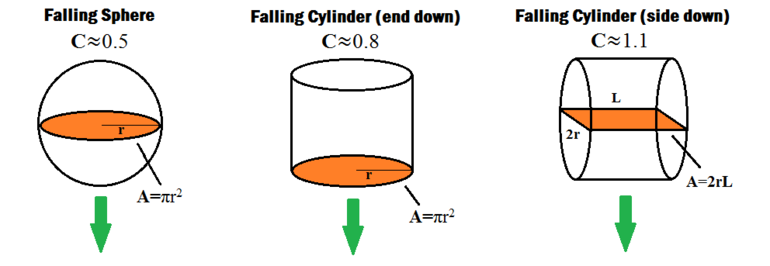Drag

Drag is a force that opposes or resists motion, caused by collisions of moving objects with molecules in a fluid like air or water. It is much like surface friction in that it opposes moving objects, except that it occurs in a moving fluid. Drag increases if an object increases its speed, has a large cross-sectional area, or if the fluid it is moving through is more dense.[2]
The equation for the drag force depends on the three factors stated above, and can be written as:[2][3]
where
is the density of the fluid (air is 1.2 kg/m3 at STP conditions)
is the cross-sectional area (see Figure 2)
is the velocity of the object
is the drag coefficient
is the drag force in the direction opposite to that of the velocity
This equation only works for ordinary objects (with a size between a few millimeters and a few meters) and ordinary speeds (no more than a few hundred meters per second), so it fails to describe the motion of very small objects like dust, or very fast objects like bullets.[2]
The flow of air through a wind turbine causes the turbine to spin, because of the collision of the particles and the turbine. It might seem strange that a stationary object can be affected by air drag, but air drag occurs when there is a relative motion between the air and the object, so it can be viewed as if the turbine is moving through the stationary wind. The wind slows down upon contact with the turbine and these collisions combined with the shape of the turbine blades allows it to spin, providing wind power.
Visit NASA to read about aircraft drag.
Drag coefficient (C)
The drag coefficient in the equation for drag is quite complex, and depends on various factors such as those listed above, and also includes air viscosity and how much it can be compressed.[4] It is usually determined experimentally, by taking measurements of an object in a wind chamber. It can also be predicted by taking all of the factors into account, and NASA goes through how this is done here. Below is a picture of various shapes and their drag coefficients.

References
- ↑ lipetkd on Pixabay [Online], Available: http://pixabay.com/p-49278/?no_redirect
- ↑ 2.0 2.1 2.2 R. D. Knight, "Drag" in Physics for Scientists and Engineers: A Strategic Approach, 3nd ed. San Francisco, U.S.A.: Pearson Addison-Wesley, 2008, ch.6, sec.5, pp. 152-154
- ↑ Hyperphysics, Air Friction [Online], Available: http://hyperphysics.phy-astr.gsu.edu/hbase/airfri.html
- ↑ NASA, The Drag Coefficient [Online], Available: https://www.grc.nasa.gov/WWW/k-12/airplane/dragco.html
- ↑ Made internally by a member of the Energy Education team, adapted from Physics for Scientists and Engineers by R. Knight.

